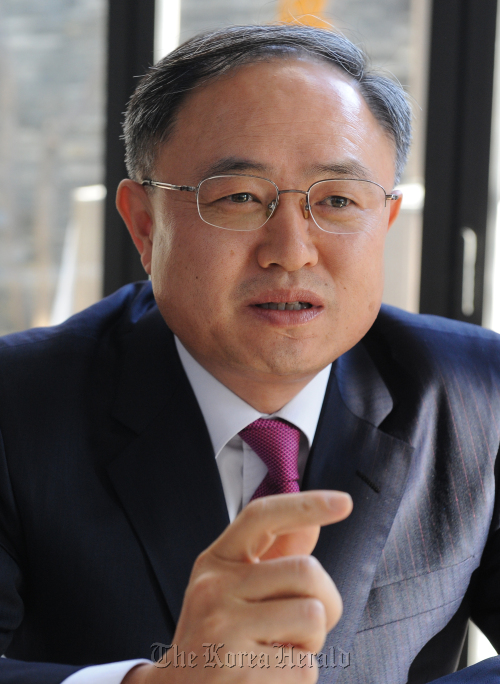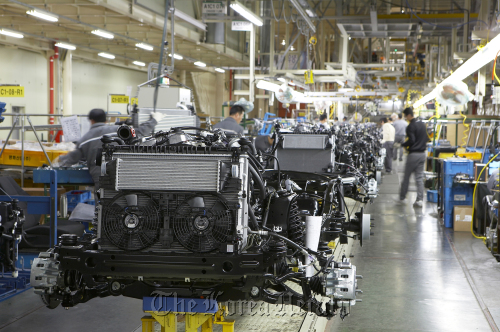[Herald Interview] Ssangyong looks to brighter future with Mahindra
By 최희석Published : March 17, 2011 - 09:20
After return to profit in 2010, carmaker hopes new models bring growth and stability
With its takeover by Mahindra and Mahindra Ltd. now complete, troubled carmaker Ssangyong Motor Co. is hoping to strengthen its product lineup, expand into new markets and rebuild its reputation.
“Ssangyong caused much trouble for Korea, and to do this (revive the company) creditors and others involved had to make great sacrifice,” Park Young-tae, who served as the company’s co-court receivership manager, said in an interview with The Korea Herald early this month.
“This is the reason for Ssangyong’s continued existence; to become a reputable company to repay the local community, the country and all those involved.”
The company paid off most of its debt with the 520 billion won ($461 million) acquisition fund paid by the Indian firm.
Even before the takeover, Ssangyong had been slowly recovering its footing since its crisis began in 2009, and its court receivership came to an official end on Monday.
Having struggled through a massive restructuring that saw more than 2,000 workers laid off or put on unpaid leave, and a drawn out strike that threatened to push the company over the edge, Ssangyong managed to post net profits for last year, the first since 2007.
Aided by a sales increase fueled by economic recovery, and sales of assets, Ssangyong’s net profits for 2010 came in at 8.1 billion won, up more than 350 billion won from 2009.
However, Park expects a return to the red in 2011 with expenditure rising as the company seeks to strengthen its lineup.
With its takeover by Mahindra and Mahindra Ltd. now complete, troubled carmaker Ssangyong Motor Co. is hoping to strengthen its product lineup, expand into new markets and rebuild its reputation.
“Ssangyong caused much trouble for Korea, and to do this (revive the company) creditors and others involved had to make great sacrifice,” Park Young-tae, who served as the company’s co-court receivership manager, said in an interview with The Korea Herald early this month.
“This is the reason for Ssangyong’s continued existence; to become a reputable company to repay the local community, the country and all those involved.”
The company paid off most of its debt with the 520 billion won ($461 million) acquisition fund paid by the Indian firm.
Even before the takeover, Ssangyong had been slowly recovering its footing since its crisis began in 2009, and its court receivership came to an official end on Monday.
Having struggled through a massive restructuring that saw more than 2,000 workers laid off or put on unpaid leave, and a drawn out strike that threatened to push the company over the edge, Ssangyong managed to post net profits for last year, the first since 2007.
Aided by a sales increase fueled by economic recovery, and sales of assets, Ssangyong’s net profits for 2010 came in at 8.1 billion won, up more than 350 billion won from 2009.
However, Park expects a return to the red in 2011 with expenditure rising as the company seeks to strengthen its lineup.

“There are several reasons, but the main reason is the cost of developing new models,” Park said. He said that the process requires twofold investment as a carmaker needs to conduct its own R&D as well as hire contractors that specialize in specific areas.
Now with Mahindra’s full backing, which according to Park promises five things ― continuing investment, investing in ways to improve Ssangyong’s brand image, replenishing the company’s technical staff, seeking win-win strategies and pursing financial stability -― Ssangyong is readying to launch a series of new models and update its current lineup.
On Tuesday, the company announced that 240 billion will be injected into its operations this year. Of the total, 200 billion won will be directed toward product development, including a new model that will be launched in 2013. The remaining 40 billion won will be injected into advertising and other efforts to repair the company’s damaged brand image in Korea. Ssangyong is also looking to bolster its domestic sales network by increasing the number of dealerships to 150 from the current 130 this year, as it aims for 121,000 units in annual sales, up 40,000 units from the 81,000 units recorded in 2010.
“There is the follow up model for the Kyron. But the platform is different so it can be considered as an entirely new vehicle which will be similar in size to the (Hyundai) Santa Fe. And the Q150 will be a sport utility truck that will be launched maybe at the end of this year,” Park said.

Ssangyong also continues to seek to expand its lineup, which currently consists entirely of recreational vehicles and luxury sedans ―- both of which are particularly sensitive to economic conditions ―- that may go some way to explain the company being hard hit by the economic downturns of 1998-99 and 2008.
“Plans for small cars are in the works, but there is nothing solid going on at present, and since Mahindra has now taken over, decisions will be made with regard to synergy with Mahindra,” Park said.
Park also projects that its connection with Mahindra will open up the Indian market within the year, where the company is considering the Korando C and the Rexton SUVs as its lead vehicles.
“I think CKD exports to India can begin within the year, and, as Mahindra already has all the necessary facilities, going into India will not require investment,” Park said. He added that as exports to India will be in knockdown kits, they will not place additional burden on the company’s production line.
He is also optimistic about the benefits gained from Mahindra’s sales network.
“Mahindra is famous for tractors and other agricultural equipment, and I have been informed that the company has a strong sales network, and I expect some efforts to aid our sales through that network,” Park said. As for Ssangyong’s existing sales network, Park said that while there are no plans to merge it with that of Mahindra at present, he is of the opinion that maintaining it at extra cost may not be necessary.
Its first new model in Korea in three years, the Korando C, launched in February.
With much riding on the vehicle, the company set an ambitious sales target of 20,000 units for this year, which is equivalent to around 66 percent of Ssangyong’s 2010 sales, and about a third of the figure for 2007, before the company became mired in financial troubles.
“I don’t think the targets are unrealistic. The current environment is unfavorable with high oil prices and unstable exchange rates, but Korando C will be our first compact RV, which from some perspective makes it a good match for current developments,” Park said. He added that Ssangyong is now turning its focus to markets to which it had previously given little attention.
“A market that does well when oil prices rise is Russia, and our CKD business in that country is doing very well. The South American markets, especially Brazil, also look very good. The company is shifting the focus from Western Europe, which has an economic structure that requires time to recover.”
The company is not home free yet, however, with the issue of those who left the company or are on unpaid leave continuing to plague the SUV specialist.
Since the sit-in strike was ended, more than 10 former Ssangyong workers, family members of workers or those on unpaid leave have taken their own lives or died from stress-related causes.
As such, some non-government organizations and politicians have assigned the blame for the deaths to Ssangyong, and have been demanding that the carmaker make good on the agreement made in August 2009.
At the negotiations that brought the strike to an end, about 460 workers were reportedly put on unpaid leave to be reinstated when the company’s operations had normalized in one year’s time, which came and went in September 2010.
Park, however, says that such reports are incorrect.
“The agreement was to reinstate once it was possible to run a two-shift system,” Park said, adding that a carmaker’s need for workers increases along with production volume, but that Ssangyong’s output remains insufficient.
“Line one produces the Korando C, but it has until recently been offline, and line two still remains idle for a lot of the time. Only line three is in full operation. It (reinstating workers) is not possible at this time.”
Having been the management’s main negotiator in the strikes two year’s ago, Park has much to say about the issue and labor-management relations of Ssangyong’s past and present.
“The most difficult things (in the negotiations of 2009) were rebuilding lost trust. And adhering to law and principles, even the government told me to settle. I can’t tell you who, but I was told that I can’t do something that does not exist in Korea and to reach settlement quickly,” Park said.
“I think that a company and the management also play a role in creating a hard-line union. If you don’t stick to rules and principle for the sake of immediate convenience, there will be corruption, and that requires a stronger union to be born. And as that process repeats, a hard-line union is created. But now Ssangyong’s union is rid of such practices,” Park said. He added that the purpose of a union is to protect the rights of the workers, but that must come with quality and productivity, a requirement that has often been ignored in Korea.
“The company and the management must be transparent. If that is given, I think the company will win every time if there is friction with the union. We have been doing well so far, but I think establishing Korea’s leading company in terms of advanced labor-management relations is also part of the reason for the company’s existence.”
By Choi He-suk (cheesuk@heraldcorp.com)








![[Kim Seong-kon] Democracy and the future of South Korea](http://res.heraldm.com/phpwas/restmb_idxmake.php?idx=644&simg=/content/image/2024/04/16/20240416050802_0.jpg&u=)







![[KH Explains] Hyundai's full hybrid edge to pay off amid slow transition to pure EVs](http://res.heraldm.com/phpwas/restmb_idxmake.php?idx=652&simg=/content/image/2024/04/18/20240418050645_0.jpg&u=20240418181020)

![[Today’s K-pop] Zico drops snippet of collaboration with Jennie](http://res.heraldm.com/phpwas/restmb_idxmake.php?idx=642&simg=/content/image/2024/04/18/20240418050702_0.jpg&u=)